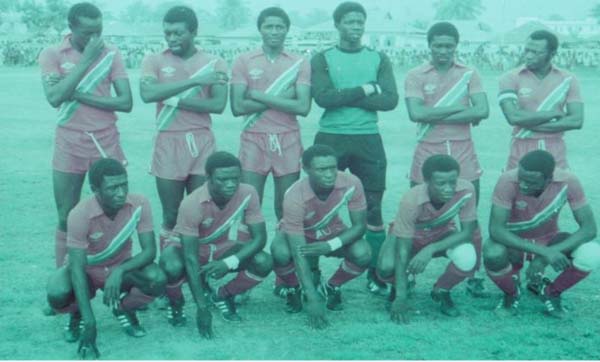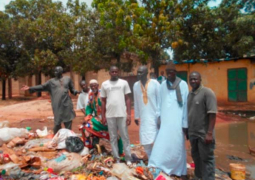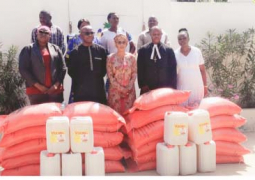
As Gambian referees are on the spot light these days,we find it imperative to re-visit the years gone by to find out how the foundation was laid and what went on behind the scenes. It is an accepted fact that there were great referee heroes in the past and they set the tone for today’s generation.
In this edition, we are please to publish an excerpt from an Insider’s Review of Gambian Football from 1975-1985 by Tijan Masanneh Ceesay, veteran Gambian Journalist and Football commentator. Tijan captured a lot on the officiating of the game in the 80’s and with his kind permission, we reproduce the chapter on referees and the fans. Enjoy!
The referees and fans of Gambian football
The Referees
The Gambia Football Association had under its auspices an independent referees association. The Gambian Referees Association was one of the most respected in the continent of Africa because of the stellar reputation of its first chairman, Alhagie Omar Sey, who had served in various capacities at both the Confederation of African Football (CAF) and International Federation of Football Associations (FIFA).
It is still believed that Omar Sey could have been the President of FIFA today if he had not opted to enter politics in The Gambia. Under his leadership, the Gambian referees grew and became an integral part of the development of football in Africa. At that time, The Gambia Referees Association registered seven referees with FIFA every year with a requirement for each to officiate three “A” matches which were international games at country level sanctioned by the world football governing body.
After three international (A) matches, based on their performances, they were now qualified for their FIFA badges for which The Gambia was never short of. The association had nine referees with full FIFA accreditation. Referees who received their FIFA badges were Alagie Omar Sey, Alhagie Mboob, Osseh Obrien Coker, Alhagie Gailoub Faye, Dodou Njie Barracks ,Seydou Sowe, Badou Jassey, Mali Joiner and Mbye Drammeh.
The Gambian referees committee became the standard for refereeing in Africa. This was put to the test when FIFA selected Alhagie Omar Sey, Seydou Sowe and Saul Sinyan to run a referee’s course in the West African country of Sierra Leone in the 80’s. With complete autonomy, the referees committee was in charge of scheduling officials for each game. In that day, they held meetings every Tuesday to review the performances for the previous week and make the necessary adjustments.
It is also a known fact that many times, other African countries have reached out to The Gambia Referees Association to come to their countries to officiate their big games. This was their reputation in Africa. Even though, back home, no one let them off the hook. In the early 80’s, one of Gambia’s most prominent referees, Dodou Njie Barracks, was voted one of the fifteen best in Africa, but he retired prematurely from refereeing for reasons that were never made public.
Speculation was rife as to why he withdrew from the game. Rumors spread like wild fire, insinuating that he officiated poorly at the Africa Cup of Nations Championship, a charge that has never been clarified. It was a major setback in a nation that believed in the phrase, “NO PROBLEM.”
As good as our referees were outside of the country, they were never exempt from criticism. Most of the criticism came from the fan group named Tally 8. It was not uncommon for Gambian referees to be accused of favoring Wallidan and Hawks. They had to deal with this label for a long time, and, to this day, many football fans of the 80’s would stand by this assertion.
They also were at loggerheads with the FA on many issues. I can vividly recall a huge game involving Wallidan that ended in a tie after extra time. The FA wanted the game to be replayed the following week so that it could raise more money. The central referee of that game said it was a flagrant violation of FIFA rules. According to the referee, the FA could have stipulated the replay in its competition rules for the tournament but that was not the case.
The FIFA rule at the time clearly stipulated that if a game ends in overtime and there was visibility, a penalty shootout should decide the winner and this is the rule that the official applied to the letter. The Gambian football association was not at all happy with this decision, but, upon going back over the FIFA rules governing the game and knowing that the Chair of The Gambian Referees was a member of the FIFA rules committee, they caved in.
The Gambian Referees Association had the upper hand when compared with other African countries and beyond, because they had one of the leading officials in the world at the time, Alhagie Omar Sey in their corner. Alhagie Omar Sey could have been FIFA’s President today, if only he had wanted to. The powerful FIFA President in the 70’s, Jao Havelange, loved and trusted Mr. Sey, and admired his knowledge of the game and his overall intellect.
In fact, through their unique relationship, Alhagie Omar Sey was able to bring President Havelange to The Gambia in 1976/77 where President Havelange ran an instructor’s course at Banjul’s St. Augustine’s High School on Box Bar Road. I was very young at the time, but I have a vivid recollection of the high marks the FIFA President gave to Alhagie Omar Sey as he notes Sey’s great contribution to the development of football officiating in the world.
Gambian referees had their ups and downs and they had very funny moments, some of which were beyond comical and would be in the minds of the fans of that generation for quite some time. In one game, two halftime periods were called.
In another, a referee pulled out a Gambian ten Dalasis currency note for a stand word of admonition instead of a yellow card. And who can forget the time that Paul Ogoo scored a canon of a goal against Real’s Jim Wadda and Osseh Coker forgot that he was the referee and jumped in celebration because of the beauty of the goal.
Uncle Badou Jasseh, ndeyssan was a national cricket player and a track and field coach and was one of Gambia’s finest referees of all time, hands down. Everyone saw his fitness and agility when he called games. I can still recall him telling players who were misbehaving that he was not going to eject them from the game.
He’d tell them, “I know you are exhausted, but the best thing to do is to tell your coach to replace you rather than trying to get me to eject you, it’s not going to happen.’ He became one of the leading referees in the continent. After he retired, he continued to serve as the Chair of the Referees Association until his untimely passing two years ago. Then there was Alhagie Gailoub Faye, another young FIFA referee.
He was a great official and had a vast knowledge of the game. He was given the biggest of assignments at continental level. Seydou Sowe was the strictest of the bunch. He controlled his games with vigour and ensured that every player knew he was the boss during those ninety minutes and you bet, the sideline was never without an ejected player as Essa Faye would confirm. The two never got along on the field. A story I still find quite funny is that of the referee who was scheduled to officiate the finals of the Brikama youth week in 1978. This particular official was so scared of the task that he developed diarrhea. Then there was “Dad.” He’d tell big stars to just get into the box and he’d call a penalty. Football fans of the day recall all these stories. I am sure they still will not forget when a player grabbed the red card from the referee and tried to rip it up, not knowing the card was actually plastic.
The Fans
When I talk of Gambian fans, I have always said that the number one fan of the game was Ebou Joof , a retired savvy veteran defender from Real De Banjul. Though he was not the most skillful at his position, his football intellect and understanding of the “libero” position were unmatched in Gambian football.
Then there was Alhagie Njie Biri, the greatest African footballer who could have easily been the “PELE” of the world under the right circumstances, and Sereign Saihou Sarr, whom I believe developed the game from a tactical standpoint like no other. These three gentlemen, whether as retired or active players, were employed at the Department of Sports and, from that vantage point, they were able to do a lot to develop the game. They not only concentrated on association football, they also brought their various areas of expertise to the school level which was a foundation for promoting the game at the time.
No one in Gambian football can talk about Gambian fans without talking about the greatest group of fans, the “Tally 8.” Nicknamed for the eight residences of their headquarters on James Senegal street in Banjul, these guys were good at what they did. They were objective critics who claimed to know and understand the game like no other. They took the association to task and some of their exchanges were not too pleasant. They would be given another nickname, “Katanga,” with reference to the Katanga’s withdrawal from The Congo on July 11th, 1960.
These guys developed their own football vocabulary that the rest of the fan base picked up. Phrases like, “NAK AM SOES,” DORR KO DALA, GAS KO, FETEL KO, SANI FA BANHAS and BUL YAHA POR MI,” became part of the game. It was all in fun. This group at the other side of the fence, were always at loggerheads with the football administrators whom they labelled as the football mafia, which did not sit well and they paid the price.
I can recall how they’d be requested to bring their student identifications to receive the discounted student rates for games. This was the way for the FA to get at them, but it never worked. “FIFA” as they would also be nicknamed , had their way and controlled that area of Box Bar Stadium, come what may.
Pa Samba Sillah, Alagie Jobe, Poek Jobe, Mr. B, Kofi Sillah, Ebou Ndure, Kebba and Adua Mbye, Alhagie Sillah and Sherrif Nyan are forever embedded in the history of Gambian football, one of their number one nemeses, a referee, would allude to me. Were they the greatest of fans, maybe not, but, they spoke their mind and stood firm on their principles, a rarity in Gambia in those days.
The history of Gambian football would not be complete if it is not associated with the late Alieu Sallah. Sallah was Wallidan’s Supporter-In-Chief. He brought so much fun to the game, especially with his pre-game rituals. He would dress up in large multi color gowns with horns. He ran from one end to another supporting his favorite, Wallidan, with trumpet in hand. There was another fellow named OYI from “half die” who was a Port Authority fan.
On game days, he walked the fence with a lot of trash talking. Another person who comes to mind is Sef Carew ndeysan! He was never short on reminding me that he was of the same age as my Mother and I needed to give him due respect when I was walking the fence for Young Africans. He was charming, loving and a very funny man who loved his dear Wallidan. Lest we forget the hundreds that made the thirty minute ride to Banjul from Serrekunda to support the area’s team, Kwame FC. They were referred to as the “DUTOE” boys, a Mandinka word for Mangoes which their area had like no other. They were pretty stout supporters who brought their gist into Box Bar Stadium, which added to the great atmosphere that still makes Box Bar Stadium irreplaceable.
For many years, great fans like Cut from White Phantoms, Ndama with the taxi cab for Real De Banjul, Pa Boy Harris for Augustinians, Amat Dimba for Starlight, Alhagie Ngoose Njie for Wallidan, Pa Phillot for Real and many others, will all be engraved with Gambian football for generations to come.
On the whole, Gambian fans were well behaved. I cannot recall a single breach of the rules when it came to the way they carried themselves. Indeed there were minor altercations here and there, but nothing extreme which really goes to further consolidate the fact that Gambian people are easy going and peaceful at all times.



